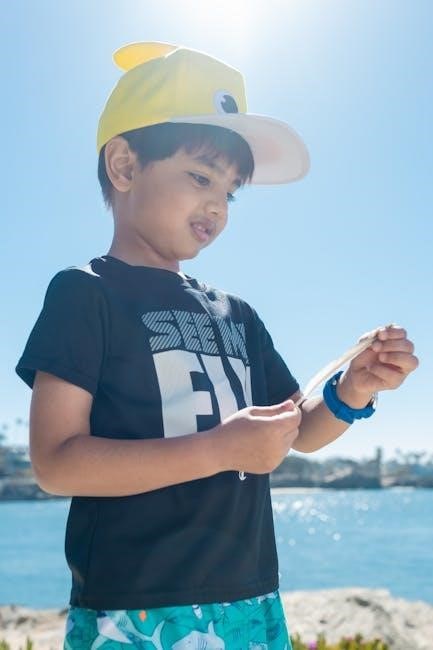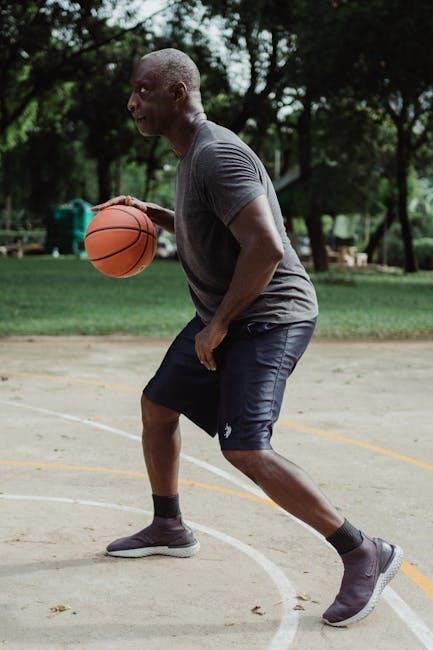Properly fitting youth t-shirts ensure comfort and confidence for kids. Understanding size charts, measurements, and growth considerations helps parents choose the right fit for their child’s unique needs.
Importance of Proper Fit
A proper-fitting youth t-shirt is essential for comfort, confidence, and practicality. Clothes that fit well allow for freedom of movement, reducing discomfort and irritation. A good fit also ensures the t-shirt looks stylish and appropriate, boosting a child’s self-esteem. Ill-fitting clothes, whether too tight or too loose, can cause discomfort and affect a child’s mood and activities. Additionally, proper fit helps prevent issues like chafing or restricted movement, which can be especially important for active kids. Ensuring the right size also extends the life of the garment, as it avoids excessive strain or stretching. For growing children, a well-fitting t-shirt is a small but meaningful detail that contributes to their overall well-being and happiness.
Understanding Size Variability
Size variability in youth t-shirts can be confusing due to differences in brands, styles, and measurement methods. While some brands follow standard size charts, others may have unique fits. Age-based sizing often serves as a general guide, but factors like height, weight, and body type can vary widely among children. Numeric sizes may also differ between brands, making it essential to compare measurements rather than relying solely on age or size labels. Fabric type and design features, such as slim-fit or relaxed styles, further influence how a t-shirt fits. Understanding these variations helps parents make informed choices, ensuring their child’s comfort and confidence in their clothing.

Measurement Techniques
Accurate measurements are key to finding the perfect fit. Measure chest circumference, height, and weight to align with size charts for a comfortable and stylish t-shirt fit.
Chest Measurement
Chest measurement is crucial for determining the right t-shirt size. To measure accurately, place a flexible tape measure around the widest part of the chest, usually just under the armpits. Ensure the tape is level and not too tight or loose. For youth sizes, this measurement typically ranges from 24 to 30 inches, corresponding to sizes S through XL. Comparing this measurement to a size chart ensures a comfortable fit. It’s important to consider the fabric type, as some materials may stretch more than others, affecting the overall fit. Always refer to the specific brand’s size chart for precise guidance, as variations can occur between brands. Accurate chest measurement helps avoid sizing mistakes and ensures the t-shirt is both comfortable and flattering. By taking the time to measure correctly, parents can ensure their child’s t-shirt fits well and meets their comfort needs. This step is essential for a successful shopping experience, especially when purchasing online where fit can’t be checked in person. Additionally, understanding how growth spurts might affect sizing can help in choosing a size that allows for a little extra room without sacrificing the desired fit style, whether it’s slim, regular, or loose. This attention to detail ensures the t-shirt remains a favorite for longer, providing both comfort and confidence for the child.

Height Measurement
Height measurement is a key factor in determining the appropriate youth t-shirt size. It helps ensure the shirt length is proportionate to the child’s body. To measure accurately, have the child stand straight against a wall, with feet flat and shoulders relaxed. Record the height in inches, as most size charts use this unit. For youth sizes, typical height ranges are 46–50 inches for size S, 51–55 inches for M, 55–59 inches for L, and 60–64 inches for XL. These ranges often align with age groups, such as 6–8 years for S and 12–14 years for XL. Using height alongside chest measurement ensures a balanced fit. Always refer to the brand’s specific size chart, as variations exist. This approach helps avoid shirts that are too short or too long, ensuring comfort and a flattering appearance. By combining height with other measurements, parents can make informed decisions for the best fit. This step is especially useful when shopping online, where fit can’t be checked in person. Additionally, considering growth spurts can help in selecting a size that allows for some growth without compromising the fit. This ensures the t-shirt remains wearable for a longer period, providing value and comfort for the child.
Weight Consideration
Weight consideration plays a role in youth t-shirt sizing, though it’s less precise than chest or height measurements. Brands often provide weight ranges to help estimate size. For example, smaller sizes (XS-S) suit lighter children, while larger sizes (L-XL) accommodate heavier builds. However, weight alone isn’t reliable due to varying body proportions. It’s best used alongside chest and height measurements to avoid sizing errors. For instance, a child who is above average weight for their height may need a larger size for comfort. Conversely, a child who is lean may prefer a slimmer fit. Using weight as a secondary guide helps ensure the t-shirt isn’t too tight or overly loose, balancing comfort and style. Always check brand-specific charts, as weight ranges can vary. This approach helps parents make informed decisions, ensuring a comfortable and flattering fit for their child;

Standard Youth Size Chart

A standard youth size chart includes age ranges, numeric sizes, chest measurements, and weight guidelines to help parents select the appropriate fit for their child.
Age-Based Sizing
Age-based sizing is a common method for determining youth t-shirt sizes, typically grouping children into ranges like 6-8, 8-10, 10-12, and 12-14 years. These ranges are designed to align with average growth patterns, ensuring a comfortable fit. However, it’s important to note that individual growth rates can vary significantly. For example, a child aged 8 might fit better in a 10-12 size due to height or build. Brands often provide charts that correlate age with chest measurements and height, helping parents make informed decisions. Combining age with other factors like chest circumference ensures a more accurate fit, as growth spurts can affect size needs. Parents should consider both age and body measurements for the best results;
Numeric Size Ranges
Numeric size ranges for youth t-shirts, such as 2-4, 6-8, 10-12, and 14-16, are based on average chest measurements and heights. These ranges correspond to specific age groups, with 2-4 typically fitting younger children and 14-16 for preteens. Numeric sizing is practical as it aligns with standard growth patterns, making it easier for parents to select the right fit. However, variations exist between brands, so consulting a size chart is essential. For example, a size 10-12 usually matches a chest measurement of 28-30 inches and a height of 55-59 inches. Numeric sizing offers a clear guide, but parents should also consider their child’s comfort and activity level when choosing a size. Always check the brand’s specific measurements for accuracy.
Brand-Specific Variations
Brand-specific variations in youth t-shirt sizing can significantly impact fit. Some brands offer numeric sizing, while others use Small, Medium, Large, and Extra-Large labels. Measurements may differ between brands due to unique cut styles, fabric types, or target audiences. For example, Gildan’s Youth Ultra Cotton t-shirts have distinct sizing compared to Nike’s performance-fit designs. Additionally, unisex sizing may vary from brand to brand, with some offering more tailored fits and others emphasizing comfort and looseness. Parents should consult individual brand size charts to ensure accuracy, as a Medium in one brand might not match another. These variations highlight the importance of comparing measurements and styles before purchasing. Always verify the specific brand’s size guide for the best fit.

How to Use a Size Chart
Measure your child’s chest and height, compare to the chart, and select the closest size. Allow room for growth and consider fabric type variations.
Comparing Measurements
Comparing your child’s measurements to a size chart ensures the best fit. Measure their chest and height, then match these to the chart’s guidelines. Use a flexible tape measure for accuracy. For chest measurement, wrap the tape around the broadest part of the chest, keeping it level. For height, measure from the floor to the top of the head. Compare these measurements to the size chart, considering both numeric and age-based sizing. If your child’s measurements fall between sizes, consider their growth pace. This method helps avoid sizing errors and ensures a comfortable, stylish fit. Always refer to the specific brand’s chart, as sizes can vary slightly between brands.
Allowing for Growth
Allowing for growth ensures your child’s t-shirt remains comfortable as they grow. Consider their growth spurts when selecting sizes. If your child is between sizes or in a growth phase, opt for the next size up. This prevents the shirt from being too tight and ensures a longer wear period. Parents should measure their child every six months to track growth and adjust sizes accordingly. Balancing a snug fit for style and a loose fit for comfort is key. Always check the size chart for age and measurement ranges to accommodate growth. This approach helps extend the life of the garment and ensures your child stays comfortable and confident. Regularly updating sizes based on growth is essential for the best fit.
Understanding Fit Styles
Understanding fit styles is crucial for selecting the perfect youth t-shirt. Common styles include slim fit, regular fit, and relaxed fit. Slim-fit shirts are tailored closely to the body, ideal for active kids or those who prefer a modern look. Regular fit offers a balanced comfort, suitable for everyday wear. Relaxed fit provides more room, great for casual occasions or children who prefer a looser feel. When choosing a fit style, consider your child’s lifestyle, body type, and personal preference. For active children, slim or regular fits are practical, while relaxed fits are better for leisure. Always review size charts to ensure the selected style aligns with your child’s measurements. This helps in achieving the desired comfort and appearance, ensuring satisfaction and confidence for your child. Understanding fit styles enhances the overall shopping experience and ensures the best possible fit.

International Size Conversion
International size conversion ensures seamless shopping across global brands. Understanding US, UK, and EU size equivalents helps match your child’s measurements to the correct size worldwide.

US to UK Sizes

Converting US to UK sizes ensures accurate fit when shopping internationally. Youth t-shirt sizes differ slightly between regions, with US sizes often labeled as XS, S, M, L, XL, while UK sizes follow a similar pattern but may vary in measurements. For example, a US size S might correspond to a UK size M, depending on the brand. Numeric sizes also have equivalents, such as US size 14 aligning with UK size 14. Age ranges further guide the conversion, with US sizes typically ranging from 2-20 and UK sizes from 2-18. Always refer to brand-specific charts, as variations exist. Proper conversion ensures comfort and avoids sizing mismatches for kids.
European Size Equivalents
European sizes for youth t-shirts are often numerical, ranging from 26 to 40, and correspond to specific chest measurements. A European size 26 typically fits a chest circumference of 66-68 cm, while size 40 accommodates 100-104 cm. These sizes align with age ranges, such as 26-28 for younger children and 36-40 for teenagers. Brands may vary, so checking specific charts is essential. European sizing focuses on actual body measurements rather than age, ensuring a more accurate fit. Parents should measure their child’s chest and compare it to the European size chart for the best results. This method minimizes guesswork and ensures comfort and style for kids.
Global Sizing Standards
Global sizing standards for youth t-shirts vary significantly across regions. In Europe, sizes are often numerical, corresponding to chest measurements in centimeters, while the US and UK use alphabetical sizes like XS to XL. These systems differ in how they relate to age, weight, and body measurements. For example, a European size 32 might align with a US size Medium, but variations exist between brands. International size charts often include conversions to help parents navigate differences. Understanding these global standards ensures parents can shop confidently across borders. Always refer to specific regional charts for accuracy, as even within Europe, Italian, French, and German sizes can differ slightly. Measuring your child and comparing to the chart ensures the best fit, regardless of the region.

Special Considerations
Consider growth spurts, fabric type, and common sizing mistakes when choosing youth t-shirts. Ensure comfort and style by balancing fit with room for growth, avoiding overly tight or loose fits.
Growth Spurts and Sizing
Growth spurts can significantly impact t-shirt sizing for children. Sudden increases in height or chest measurements may require adjusting sizes more frequently than usual. Parents should consider not only the current measurements but also anticipate future growth when selecting sizes. Allowing a little extra room ensures the t-shirt remains comfortable and fits well even as the child grows. However, too much room can make the shirt look oversized. Balancing growth potential with current fit is key to avoiding frequent purchases and ensuring the child feels confident in their clothing. Regularly checking size charts and measuring can help keep up with these changes effectively.
Fabric Type Impact
Fabric type significantly influences the fit and comfort of youth t-shirts. Cotton is a popular choice for its softness and breathability, but it may shrink slightly after washing. Synthetic fabrics, like polyester or blends, offer durability and moisture-wicking properties, which can be ideal for active kids. Stretchy fabrics, such as those with elastane, provide a snug fit and flexibility. Parents should consider the fabric type when selecting sizes, as some materials may have a tighter or looser weave. Understanding how fabrics behave ensures a better fit and enhances comfort for children, especially during growth spurts or physical activities. Always check the care label for specific fabric care instructions to maintain the shirt’s shape and size.
Common Sizing Mistakes
One of the most frequent errors when selecting youth t-shirts is relying solely on age-based sizing without considering individual measurements. Parents often overlook the importance of measuring chest and height, leading to ill-fitting clothes. Another mistake is assuming all brands follow the same size standards, which can result in inconsistent fits. Additionally, some parents neglect to account for growth spurts, ordering shirts that are too tight after a few months. To avoid these pitfalls, always compare measurements to the size chart and consider the fabric type, as some materials may shrink or stretch differently. By double-checking these factors, parents can ensure a comfortable and flattering fit for their children.
Choosing the right youth t-shirt size ensures comfort, confidence, and style. By using size charts, considering growth, and understanding fit preferences, parents can make informed, practical decisions effortlessly.
Key Takeaways
When selecting youth t-shirts, accuracy is key. Always measure the child’s chest and height, and compare these to the size chart for the best fit. Consider growth spurts and leave room for comfort without sacrificing style. Be aware that brands may vary slightly in sizing, so check specific charts. If unsure, opt for a slightly larger size to accommodate future growth. Understanding the difference between slim-fit, regular, and relaxed styles ensures the child’s comfort and preference. Lastly, international size conversions can differ, so double-check measurements when shopping from global brands. Using these guidelines helps parents make informed decisions for their child’s wardrobe.
Final Tips for Parents
Parents should regularly measure their child to ensure accurate sizing, as growth spurts can quickly outdate previous measurements. Opting for breathable fabrics like cotton ensures comfort and durability. Consider the child’s activity level—active kids may prefer a looser fit, while others might like a more tailored look. When shopping online, check the brand’s size chart and read reviews for fit feedback. Allow for a little extra room in measurements to accommodate growth without sacrificing style. Finally, teach children how to measure themselves, fostering independence in choosing clothes that fit well and feel great.
